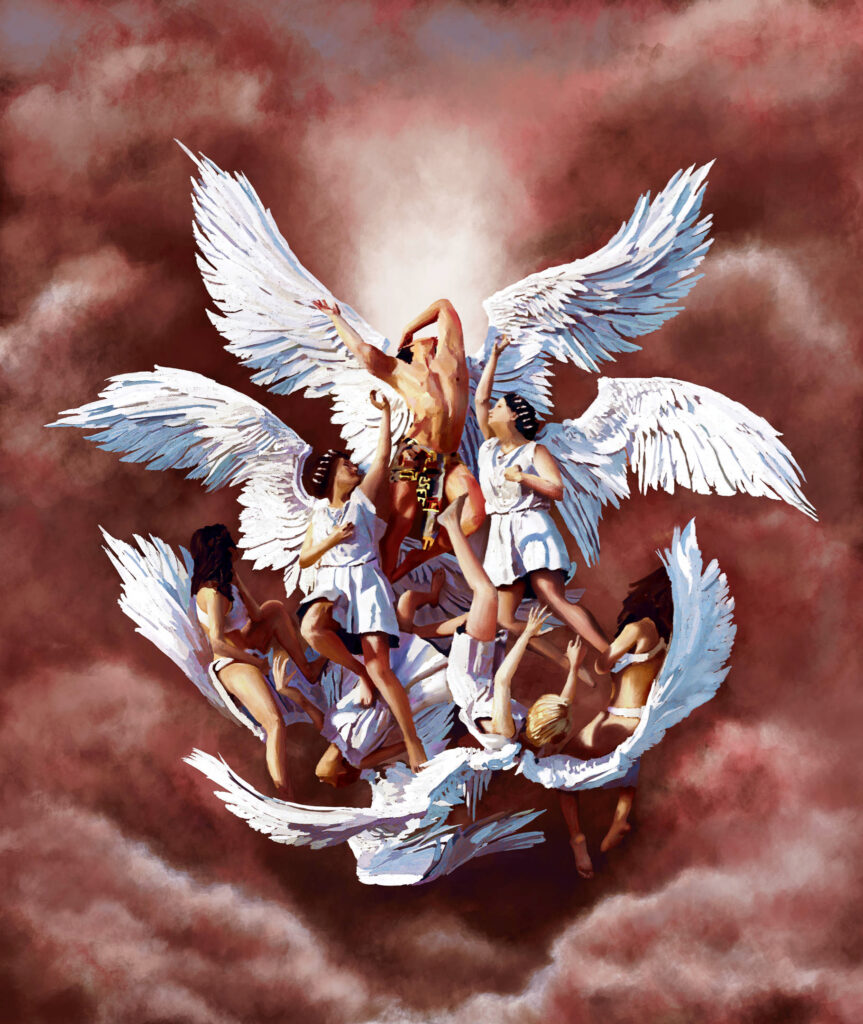The Making of: Lust

I chose the Archangel Raphael as the story’s protagonist due to this passage from Enoch 1 where he is declared to be:
“one of the four presences set over all the diseases and all the wounds of the children of men”
The Book of Enoch, Section II
Quite the burden, even for a divine being. A burden that I imagined would eventually lead even the most devout of angels to desire the human complexities born of suffering and pain over the monotony of heaven.
THE ARTWORK
Tools used: Affinity Photo, Blender
I wanted Lust to have a decidedly Baroque/Dutch Golden Age feel, so I chose colors based on the palettes of Caravaggio and Rembrandt. Later on, I ended up using adjustment layers to shift the overall hue to a red/pink tone to further evoke the feeling of lust.
PRIMING
I often use a single base color to help alleviate the “white canvas” syndrome and set a general mood. For this piece, I started with a Shakhnazarskaya red, but chose yellow ochre as a base instead because the red was too piercing for a base layer.

COMPOSITION
The design for Lust was based on compositions by Le Brun, David, and Poussin. The Assumption of the Virgin was a particularly inspiring piece (which I even did a study of!), and was the basis for the ovular central design. Beyond that, all of the figures and wings are pointed – in some way – towards Raphael in a “spoke wheel” style.
PAINTING PROCESS
I always paint on a single layer, and begin with the most important elements of the piece. In this case, the figures. For difficult poses I used a 3d model with a sunlight HDRI designed to mimic the lighting I wanted in the piece. Blender is a fantastic tool for this kind of work (and it’s free!).
Once the sketch is laid down and I’ve made some guides for lighting, I fill shapes (e.g. a full figure or a piece of clothing) with a mid-tone color then work in the shadows and finally the highlights.
Finally, contrary to what most popular artists will tell you, brushes are important. I use a combination of Greg Rutkowski’s brush sets in conjunction with Frankentoon’s Nomad set. For specialty work – like clouds, grass, or rocks – I use custom brushes to speed up my workflow.
BACKGROUND
In keeping with the classical style, I chose clouds as the backdrop for the figures. They provided the perfect blend of complexity and simplicity of shape so as not to detract from the figures. And, since their shapes are universally recognizeable, it gave me some freedom of control with the color scheme as well (hence the pinkish tinge!).
Final touches were added using Affinity Photos live highpass filter to sharpen the figures a little and help them stand out from the background. I used a degree of 2, and masked out the areas I didn’t want sharpened.
THE MUSIC
Tools: FL Studio
I’ve always loved the idea of using Renaissance/Baroque ornamentation styles with modern electronic sounds. It’s a sound that is prevalent in almost all of my work. Lust provided a great opportunity to mirror the elegance of string runs and arpeggios against a wall of gritty synthesized sounds.
DRUMS
I used Heavyocity DAMAGE for most of the cinematic drums and a custom acoustic kit for the choruses. The snare is layered with some white noise and the sound of a whip for a little extra “snap”. And since most of the libraries’ sounds come premixed, the processing on my part was very minimal. That said, I do always perform surgical cuts in the 200-300 Hz area because those frequencies don’t sound pleasant to my ears.
BASSES
Most of the bass sounds are Serum saw waves caked with distortion and compression, then resampled a few times. The pluck basses are styled after the classic 80s bass plucks and then run through distortion units for some grit.
ORCHESTRATION
Compositionally this piece is just as simple as the painting; an intro, verse, chorus, and breakdown which repeats with slight variations. I played all of the string parts live and then translated them into MIDI instruments. The guitar at the beginning was a last minute addition which I thought nicely represented Raphael’s curiosity at his newfound desires.
FINAL THOUGHTS
I tried to cover the biggest points of my process in this article, however if there is some part you would like me to elaborate on please feel free to reach out on social media! I love talking about the process behind the work.
© 2025 Visaic. All Rights Reserved.
